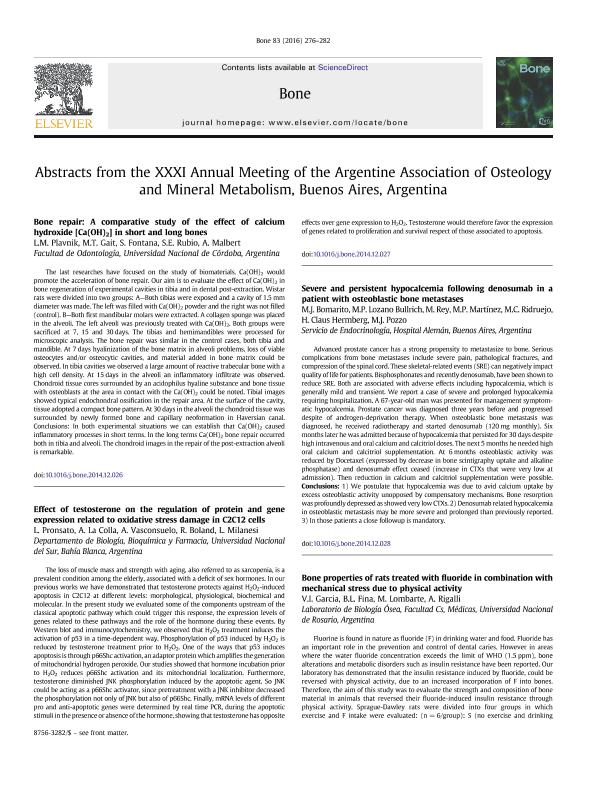Mostrar el registro sencillo del ítem
dc.contributor.author
Pronsato, Lucía

dc.contributor.author
la Colla, Anabela Belén

dc.contributor.author
Vasconsuelo, Andrea Anahi

dc.contributor.author
Boland, Ricardo Leopoldo

dc.contributor.author
Milanesi, Lorena Magdalena

dc.date.available
2018-03-28T18:56:05Z
dc.date.issued
2016-02
dc.identifier.citation
Pronsato, Lucía; la Colla, Anabela Belén; Vasconsuelo, Andrea Anahi; Boland, Ricardo Leopoldo; Milanesi, Lorena Magdalena; Effect of testosterone on the regulation of protein and gene expression related to oxidative stress damage in C2C12 cells; Elsevier Science Inc; Bone; 83; 2-2016; 276
dc.identifier.issn
8756-3282
dc.identifier.uri
http://hdl.handle.net/11336/40451
dc.description.abstract
The loss of muscle mass and strength with aging, also referred to as sarcopenia, is a prevalent condition among the elderly, associated with a deficit of sex hormones. In our previous works we have demonstrated that testosterone protects against H2O2-induced apoptosis in C2C12 at different levels: morphological, physiological, biochemical andmolecular. In the present study we evaluated some of the components upstream of the classical apoptotic pathway which could trigger this response, the expression levels of genes related to these pathways and the role of the hormone during these events. By Western blot and immunocytochemistry, we observed that H2O2 treatment induces theactivation of p53 in a time-dependent way. Phosphorylation of p53 induced by H2O2 is reduced by testosterone treatment prior to H2O2. One of the ways that p53 induces apoptosis is through p66Shc activation, an adaptor proteinwhichamplifies the generation of mitochondrial hydrogen peroxide. Our studies showed that hormone incubation prior to H2O2 reduces p66Shc activation and its mitochondrial localization. Furthermore, testosterone diminished JNK phosphorylation induced by the apoptotic agent. So JNKcould be acting as a p66Shc activator, since pretreatment with a JNK inhibitor decreased the phosphorylation not only of JNK but also of p66Shc. Finally, mRNA levels of different pro and anti-apoptotic genes were determined by real time PCR, during the apoptotic stimuli in the presence or absence of the hormone, showing that testosterone has opposite effects over gene expression to H2O2. Testosterone would therefore favor the expression of genes related to proliferation and survival respect of those associated to apoptosis.
dc.format
application/pdf
dc.language.iso
eng
dc.publisher
Elsevier Science Inc

dc.rights
info:eu-repo/semantics/openAccess
dc.rights.uri
https://creativecommons.org/licenses/by-nc-sa/2.5/ar/
dc.subject
Testosterone
dc.subject
Apoptosis
dc.subject
Skeletal Muscle
dc.subject.classification
Otras Ciencias Biológicas

dc.subject.classification
Ciencias Biológicas

dc.subject.classification
CIENCIAS NATURALES Y EXACTAS

dc.title
Effect of testosterone on the regulation of protein and gene expression related to oxidative stress damage in C2C12 cells
dc.type
info:eu-repo/semantics/article
dc.type
info:ar-repo/semantics/artículo
dc.type
info:eu-repo/semantics/publishedVersion
dc.date.updated
2018-03-28T16:56:11Z
dc.journal.volume
83
dc.journal.pagination
276
dc.journal.pais
Estados Unidos

dc.journal.ciudad
Amsterdam
dc.description.fil
Fil: Pronsato, Lucía. Consejo Nacional de Investigaciones Científicas y Técnicas; Argentina. Universidad Nacional del Sur. Departamento de Biología, Bioquímica y Farmacia; Argentina
dc.description.fil
Fil: la Colla, Anabela Belén. Universidad Nacional del Sur. Departamento de Biología, Bioquímica y Farmacia; Argentina
dc.description.fil
Fil: Vasconsuelo, Andrea Anahi. Universidad Nacional del Sur. Departamento de Biología, Bioquímica y Farmacia; Argentina
dc.description.fil
Fil: Boland, Ricardo Leopoldo. Universidad Nacional del Sur. Departamento de Biología, Bioquímica y Farmacia; Argentina
dc.description.fil
Fil: Milanesi, Lorena Magdalena. Universidad Nacional del Sur. Departamento de Biología, Bioquímica y Farmacia; Argentina
dc.journal.title
Bone

dc.relation.alternativeid
info:eu-repo/semantics/altIdentifier/doi/http://dx.doi.org/10.1016/j.bone.2014.12.027
dc.relation.alternativeid
info:eu-repo/semantics/altIdentifier/url/http://www.thebonejournal.com/article/S8756-3282(14)00487-6/fulltext
Archivos asociados
